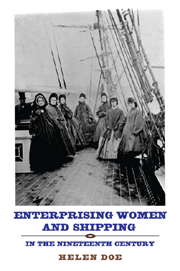Book contents
- Frontmatter
- Contents
- List of Tables and Figures
- List of Illustrations
- Dedication
- Acknowledgements
- Abbreviations
- Introduction
- 1 The Legal, Financial and Cultural Environment
- 2 Maritime Communities
- 3 Five Investor Ports
- 4 Shipowning Wives, Widows and Spinsters
- 5 Active and Passive Female Shipowners
- 6 Managing Owners
- 7 Port Businesswomen
- 8 Warship Builders
- 9 Merchant Shipbuilders
- 10 Conclusion: ‘A Respectable and Desirable Thing’
- Appendices
5 - Active and Passive Female Shipowners
Published online by Cambridge University Press: 12 September 2012
- Frontmatter
- Contents
- List of Tables and Figures
- List of Illustrations
- Dedication
- Acknowledgements
- Abbreviations
- Introduction
- 1 The Legal, Financial and Cultural Environment
- 2 Maritime Communities
- 3 Five Investor Ports
- 4 Shipowning Wives, Widows and Spinsters
- 5 Active and Passive Female Shipowners
- 6 Managing Owners
- 7 Port Businesswomen
- 8 Warship Builders
- 9 Merchant Shipbuilders
- 10 Conclusion: ‘A Respectable and Desirable Thing’
- Appendices
Summary
‘Girls never have any capital, they hardly know what it means’, wrote Bessie Parkes in 1865. She was writing about the limited options for women to be financially independent, and might have been surprised at the extent to which her contemporaries in maritime communities used their financial muscle. In the previous chapter, the shipowners and their investment decisions were considered in the context of their marital status. In this chapter their actions in relation to the shares are considered, in particular the women's attitude to the shares. Were they caretaking an inheritance or actively pursuing and managing investments in the uncertain world of shipping? There were safer options for their investments, such as government securities.
Debates about women investors have questioned whether they actively engaged with their investments. Within joint stock companies, where financial information on shares is also available, three types of women investors have been identified: speculators who bought and sold for gain, women in search of income, and women as family members. This last group held their shares by default, enabling the family to retain control of the firm or acting as caretakers for the next generation. The categories of women ship shareholders do not fit neatly into these categories, although there is some limited evidence of each of these investor types, because the nature of the main source is different from company share registers.
- Type
- Chapter
- Information
- Enterprising Women and Shipping in the Nineteenth Century , pp. 102 - 126Publisher: Boydell & BrewerPrint publication year: 2009



